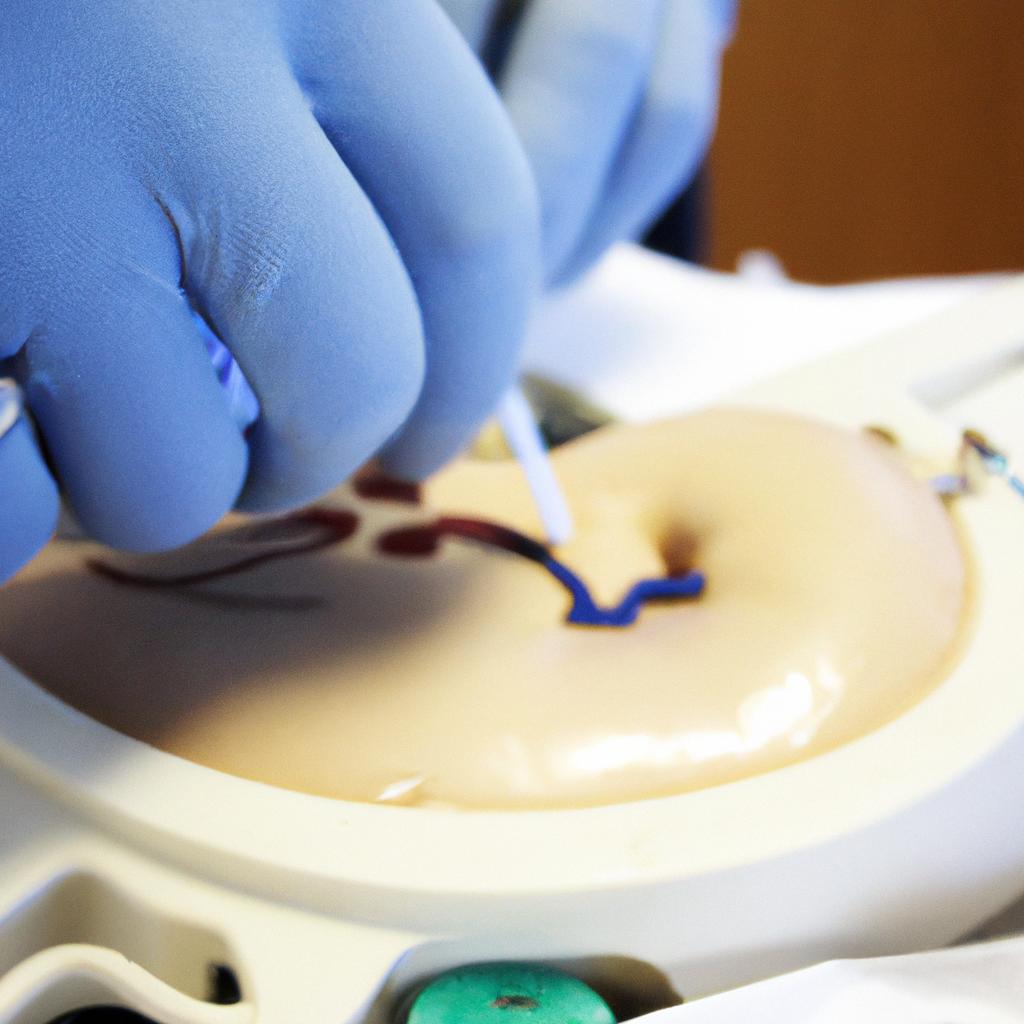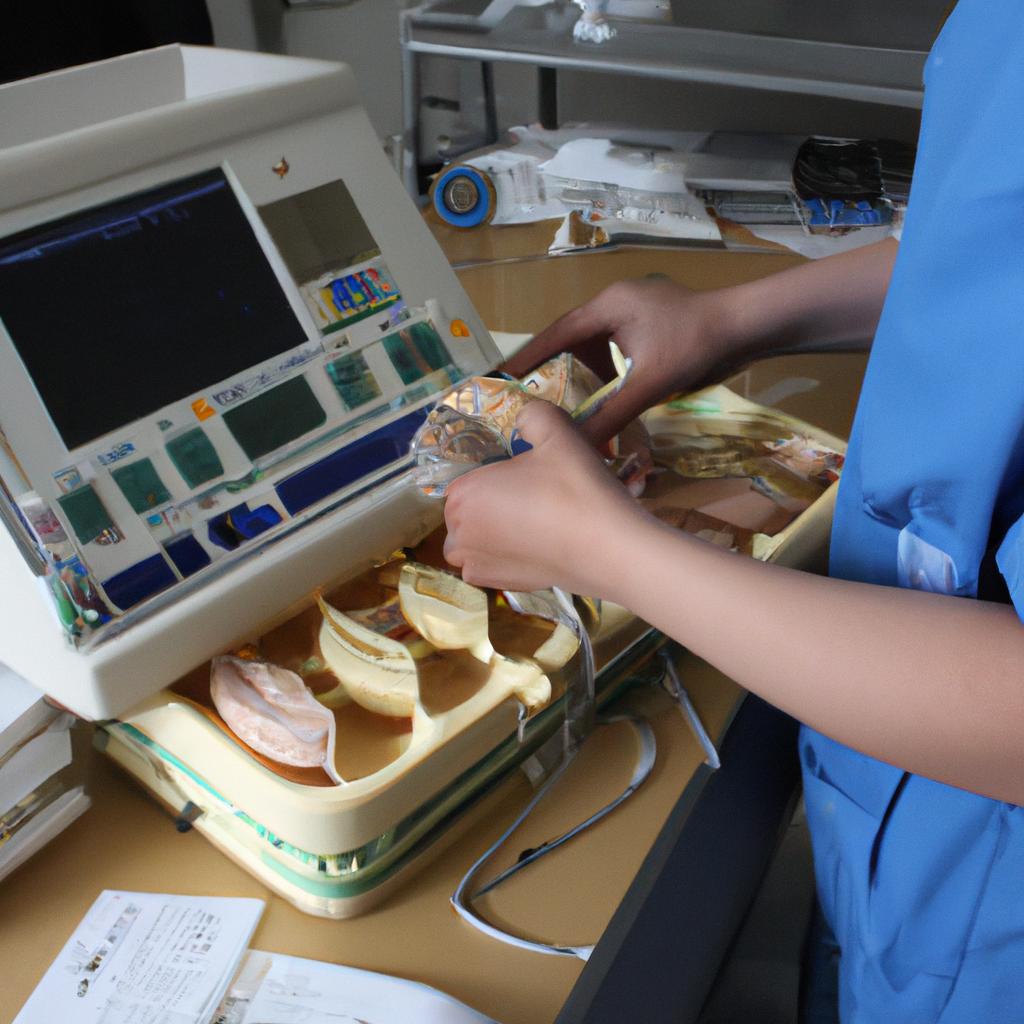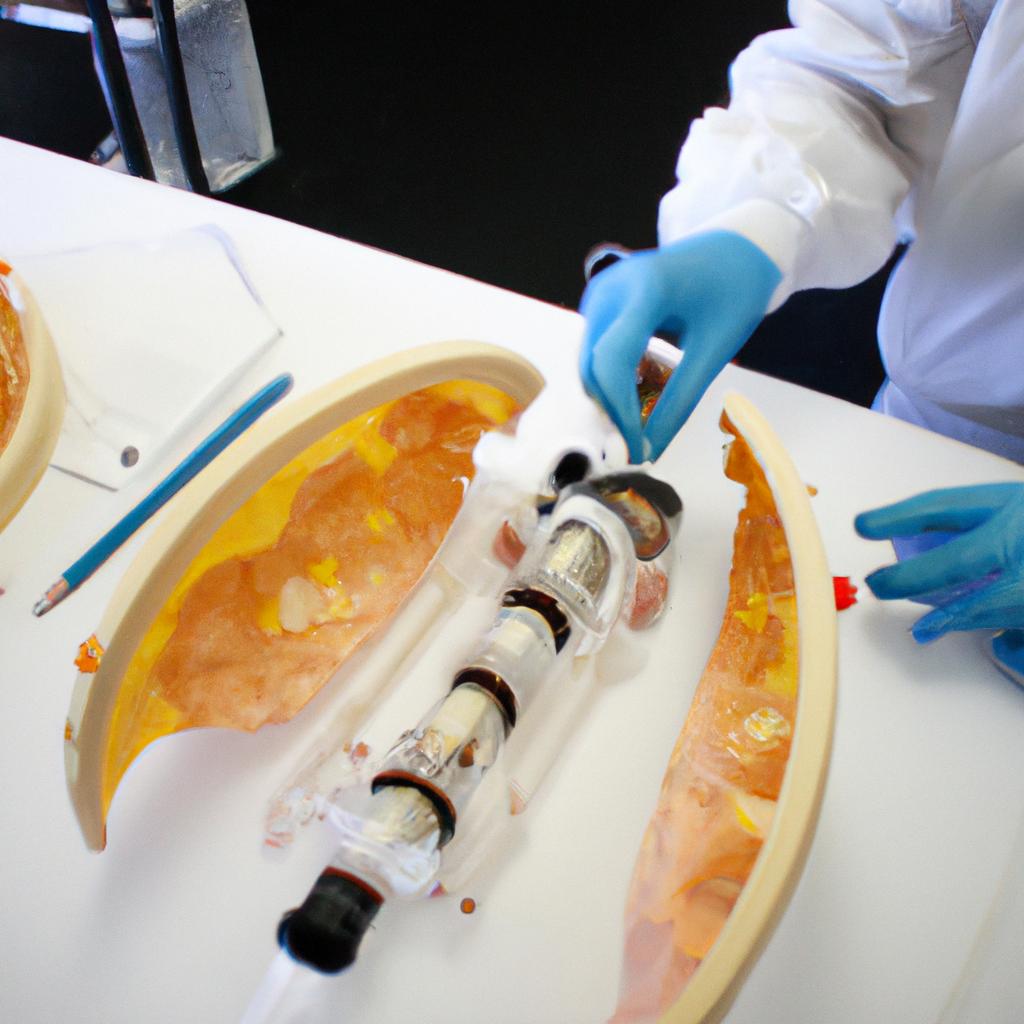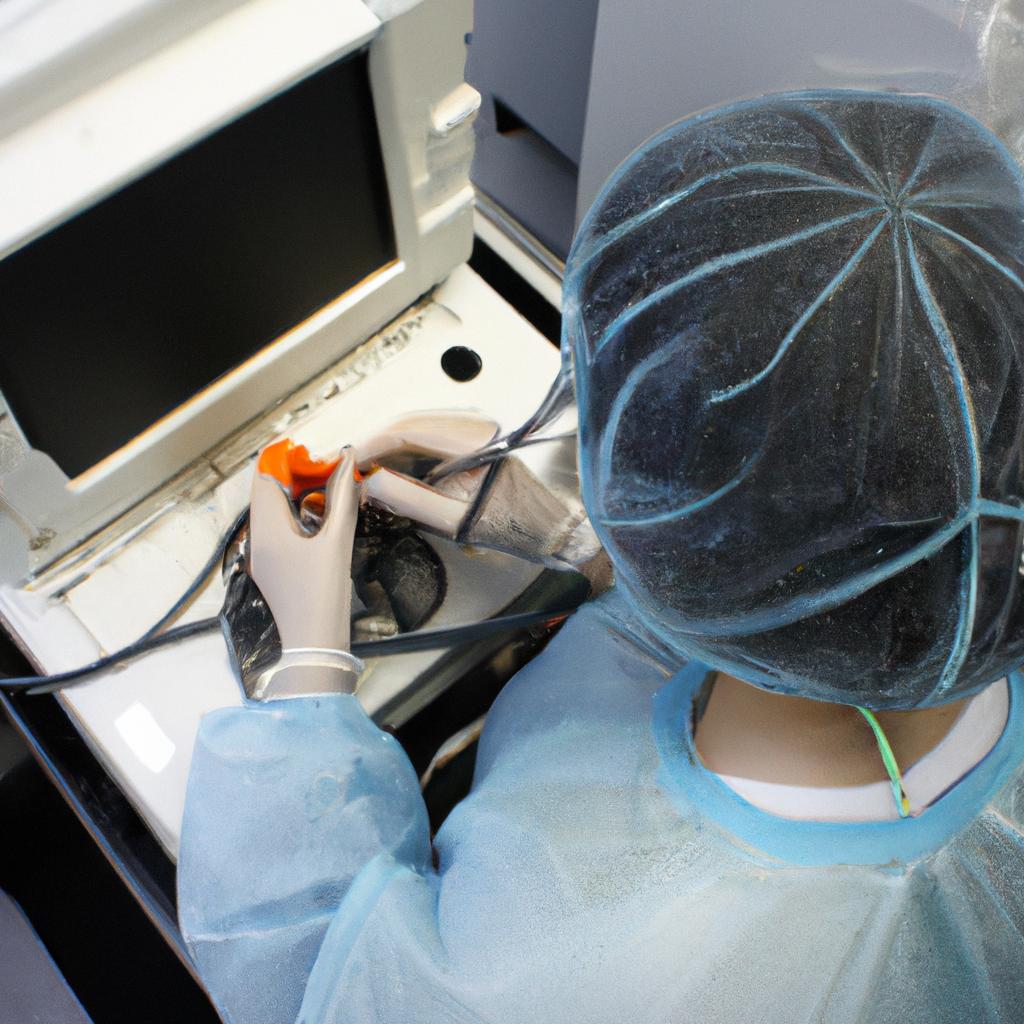The field of engineering in medicine has undergone remarkable advancements over the years, revolutionizing the development and implementation of artificial organs. Among these significant breakthroughs is the future potential for developing an artificial kidney that could offer a lifesaving solution to patients suffering from end-stage renal disease (ESRD). This article explores the current state of artificial kidney development, including technological innovations and challenges on the horizon.
One compelling example showcasing the significance of engineering in medicine can be found in the case study of Mr. Johnson, a 45-year-old patient diagnosed with ESRD. With his kidneys failing to adequately filter waste products and maintain fluid balance, Mr. Johnson’s health rapidly deteriorated, requiring him to undergo regular dialysis sessions or seek a suitable kidney transplant donor. However, due to organ scarcity and compatibility issues, both options posed significant challenges for him. In light of such cases, researchers have turned their attention towards developing an artificial kidney that not only replicates but surpasses the functions performed by its biological counterpart.
To achieve this ambitious goal, engineers are leveraging cutting-edge technologies such as nanofabrication techniques, biomaterial sciences, and microfluidics. These interdisciplinary efforts aim to engineer functional units capable of mimicking the intricate structure and physiological processes present within the human kidney. One key aspect of artificial kidney development involves creating a filtration system that can effectively remove waste products and excess fluids from the blood.
Nanofabrication techniques play a crucial role in designing and manufacturing the intricate filters required for this purpose. By manipulating materials at the nanoscale, engineers can create nanoporous membranes with precise pore sizes to selectively filter different molecules based on their size and charge. This allows for efficient removal of toxins while retaining essential substances like proteins and nutrients.
Biomaterial sciences also contribute significantly to artificial kidney development by providing biocompatible materials that can integrate seamlessly with the body’s tissues and cells. These materials need to be able to withstand repeated exposure to bodily fluids without causing adverse reactions or degradation over time.
Microfluidics is another area of focus, enabling the creation of complex networks of tiny channels that mimic the blood vessels within the kidneys. These microchannels allow for controlled flow rates and distribution of fluids, facilitating efficient filtration processes.
However, several challenges remain in achieving a fully functional artificial kidney. One major obstacle is ensuring long-term stability and durability of the device. The artificial kidney must be able to sustain continuous use over an extended period without experiencing mechanical failures or loss of functionality.
Another challenge lies in addressing immunological responses. Since the artificial kidney will come into direct contact with the patient’s blood, it needs to have mechanisms in place to prevent clotting or triggering immune reactions that could lead to device failure or harm to the patient.
Additionally, optimizing energy consumption and minimizing device size are ongoing concerns for engineers working on developing an artificial kidney that is both portable and practical for everyday use.
In conclusion, engineering plays a vital role in advancing artificial kidneys by leveraging technologies such as nanofabrication, biomaterial sciences, and microfluidics. While significant progress has been made, further research is necessary to overcome challenges related to long-term stability, immunological responses, energy efficiency, and device size. The development of a functional and reliable artificial kidney holds immense potential to transform the lives of patients with end-stage renal disease, offering them a lifeline beyond dialysis or transplantation.
Current Challenges in Kidney Transplantation
Kidney transplantation is a life-saving procedure for individuals with end-stage renal disease (ESRD), providing them with the opportunity to regain their quality of life. However, despite advancements in medical science, kidney transplantation still faces several challenges that limit its effectiveness and accessibility.
One of the main obstacles in kidney transplantation is the scarcity of donor organs. The demand for kidneys far exceeds the supply, resulting in long waiting lists and delayed treatment for patients in need. For instance, consider the case of John, a 45-year-old man suffering from ESRD who has been on the transplant list for over three years. His deteriorating health condition impairs his ability to work and enjoy daily activities, while he anxiously waits for a suitable donor organ to become available.
Moreover, even when a compatible donor organ becomes available, there are additional challenges associated with immunological compatibility between the transplant recipient and the donor organ. Rejection by the recipient’s immune system remains a significant concern post-transplantation. Immunosuppressive medications can help mitigate this risk; however, they come with their own set of complications and side effects such as increased susceptibility to infections and malignancies.
To further illustrate these challenges, let us examine some key concerns:
- Limited availability: According to data from national organ procurement organizations, only a fraction of potential deceased donors actually become eligible due to various reasons such as advanced age or medical conditions.
- Geographic disparities: Organ allocation systems may result in unequal access across different regions, leading to discrepancies in wait times and outcomes.
- Long-term management: Even after successful transplantation, recipients require lifelong monitoring and care to prevent graft rejection and manage other associated comorbidities.
- Ethical considerations: Allocation policies must strike a delicate balance between maximizing utility through fair distribution and ensuring equitable access for all individuals regardless of socioeconomic factors.
| Challenge | Impact |
|---|---|
| Scarcity of donor organs | Prolonged waiting times and increased mortality rates |
| Immunological compatibility | Risk of rejection and dependency on immunosuppressive medications |
| Limited availability | Inequality in access to transplantation services |
| Long-term management | High healthcare costs and ongoing medical care requirements |
In light of these challenges, advancements in bioengineering offer promising alternatives for renal replacement therapy. The subsequent section will explore the recent developments in this field, highlighting how engineering principles are being employed to tackle the limitations inherent in kidney transplantation.
Through a multidisciplinary approach involving engineering expertise, biological sciences, and clinical knowledge, researchers aim to develop artificial kidneys that can function as efficiently as their natural counterparts. By addressing the challenges associated with organ scarcity, immunological barriers, and long-term management, these innovations have the potential to revolutionize the field of renal replacement therapy.
Advancements in Bioengineering for Renal Replacement Therapy
One striking example of how bioengineering is revolutionizing renal replacement therapy can be observed through the development of artificial kidneys. These innovative devices aim to mimic the function of a natural kidney, providing hope for patients suffering from end-stage renal disease. By employing cutting-edge technologies and materials, researchers are making significant strides towards creating more efficient and accessible solutions.
One key area where advancements have been made is in the design and fabrication of biomaterials used in artificial kidneys. These biomaterials play a crucial role in facilitating the filtration process while ensuring compatibility with the human body. For instance, scientists have developed novel biocompatible membranes that possess enhanced permeability and filtering capabilities. This allows for better removal of waste products and toxins from the blood during hemodialysis or ultrafiltration treatments.
In addition to biomaterials, bioengineers have focused on improving fluid dynamics within artificial kidneys. By optimizing flow patterns and channel geometries, they aim to enhance filtration efficiency and minimize complications such as clotting or blockages. Computational modeling techniques have proven invaluable in simulating these complex fluid behaviors, aiding in the design optimization process.
The integration of electronics into artificial kidneys has also yielded promising results. With sensors embedded throughout the device, real-time monitoring of various parameters such as blood pressure, pH levels, and electrolyte balance becomes possible. This not only enables personalized treatment adjustments but also enhances patient safety by alerting healthcare providers to any abnormalities.
These advancements bring us closer to realizing the full potential of bioengineered solutions for renal replacement therapy. However, challenges still exist on this path toward widespread clinical implementation:
- Cost-effectiveness: Ensuring affordability remains a critical factor for broad accessibility.
- Longevity: Artificial kidneys must demonstrate longevity comparable to traditional transplant options.
- Biocompatibility: Continued efforts are needed to improve compatibility with different patient populations.
- Regulatory approval: Rigorous testing and approval processes are crucial to ensure safety and efficacy.
The table below provides a visual representation of the advancements discussed in this section:
| Advancements | Description |
|---|---|
| Biomaterials | Novel biocompatible membranes with enhanced permeability |
| Fluid dynamics | Optimized flow patterns and channel geometries for improved filtration |
| Integrated electronics | Real-time monitoring capabilities through embedded sensors |
As we delve further into the realm of renal replacement therapy, nanotechnology and nanomaterials play an integral role. The subsequent section will explore their potential applications in artificial kidney development, pushing the boundaries of what is currently achievable in this field.
Nanotechnology and Nanomaterials in Artificial Kidney Development
Advancements in Bioengineering for Renal Replacement Therapy have paved the way for groundbreaking developments in Artificial Kidney Development. One notable example is the development of a bioartificial kidney using tissue engineering techniques. This innovative approach aims to create an artificial organ that can closely mimic the structure and function of a natural kidney, providing patients with end-stage renal disease (ESRD) a life-saving alternative to dialysis or transplantation.
One key aspect driving progress in this field is the utilization of nanotechnology and nanomaterials. These remarkable technologies offer unique properties at the nanoscale level, allowing scientists to engineer materials with enhanced functionalities for use in artificial kidneys. For instance, researchers have successfully developed nanoporous membranes capable of selectively filtering waste products from blood while retaining essential nutrients and proteins. Moreover, nanostructured scaffolds provide an ideal environment for supporting the growth and differentiation of stem cells into functional kidney tissue.
The potential impact of these advancements cannot be overstated. They hold promise for revolutionizing renal replacement therapy by offering several advantages over current methods such as dialysis or transplantation:
- Improved biocompatibility: Nanomaterials can be designed to reduce immune responses and enhance compatibility between artificial organs and host tissues.
- Enhanced functionality: The precise control over material properties at the nanoscale allows for improved filtration efficiency, toxin removal, and fluid balance regulation.
- Long-term viability: Tissue-engineered constructs incorporating nanomaterials can promote cell survival and prevent rejection, leading to increased longevity of artificial kidneys.
- Personalized medicine: Nanotechnology enables customization of synthetic organs based on individual patient needs, optimizing treatment outcomes.
To further illustrate these advancements, consider Table 1 below which highlights some key features offered by bioengineered artificial kidneys compared to traditional approaches:
Table 1: Comparison between Bioengineered Artificial Kidneys and Traditional Approaches
| Features | Bioengineered Artificial Kidneys | Traditional Approaches |
|---|---|---|
| Efficient waste removal | Yes | Limited |
| Selective nutrient retention | Yes | No |
| Reduced immune response | Yes | Varies |
| Fluid balance regulation | Yes | Partially |
As researchers continue to refine bioengineering techniques and explore the potential of nanotechnology, the future looks promising for artificial kidney development. The next section will delve into the concept of Bioartificial Kidney: Bridging the Gap between Dialysis and Transplantation, which explores combining tissue engineering with regenerative medicine approaches to create a fully functional replacement organ.
[Transition sentence] Building upon advancements in bioengineering, the concept of a bioartificial kidney offers a unique approach that aims to bridge the gap between dialysis and transplantation without relying on an external device or donor organs.
Bioartificial Kidney: Bridging the Gap between Dialysis and Transplantation
Section: Bioartificial Kidney: Bridging the Gap between Dialysis and Transplantation
As nanotechnology and nanomaterials continue to advance, researchers are exploring innovative solutions for the development of artificial kidneys. One promising approach is the concept of a bioartificial kidney, which aims to bridge the gap between dialysis and transplantation. This section will discuss the potential of bioartificial kidneys in providing more effective and long-term treatment options for patients with end-stage renal disease (ESRD).
To illustrate the impact of bioartificial kidneys, consider the following hypothetical scenario: John, a 45-year-old patient diagnosed with ESRD, has been relying on conventional hemodialysis for several years. Despite undergoing regular dialysis sessions, he continues to experience complications such as fluid imbalances and electrolyte disturbances. The limitations of current dialysis techniques highlight the need for alternative approaches that can better mimic the functions of natural kidneys.
Bioartificial kidneys offer several advantages over traditional dialysis methods:
- Enhanced filtration: By incorporating advanced nanomaterials, bioartificial kidneys can provide improved filtration capabilities compared to conventional dialyzers.
- Biocompatibility: These devices aim to closely replicate the biocompatibility of natural kidneys, reducing adverse reactions or side effects associated with existing treatments.
- Regulation of blood pressure: Bioartificial kidneys have the potential to regulate blood pressure more effectively by mimicking natural feedback mechanisms within the body.
- Longevity: With advancements in tissue engineering and biomaterials, bioartificial kidneys may offer longer lifespans than currently available alternatives.
| Advantages |
|---|
| Enhanced filtration |
While significant progress has been made in this field, challenges remain in developing fully functional bioartificial kidneys that can be safely implanted into patients. Researchers must overcome issues such as immune rejection, biocompatibility of materials, and the integration of complex biological components within these devices.
In conclusion, bioartificial kidneys hold immense potential in revolutionizing the treatment options available for patients with ESRD. Incorporating nanotechnology and advanced biomaterials, these innovative devices aim to bridge the gap between dialysis and transplantation by providing enhanced filtration, improved biocompatibility, better blood pressure regulation, and increased longevity compared to traditional dialysis methods. The next section will delve into regenerative medicine approaches for kidney tissue engineering.
Transition Sentence:
Moving forward from bioartificial kidneys, researchers are also exploring regenerative medicine approaches for kidney tissue engineering.
Regenerative Medicine Approaches for Kidney Tissue Engineering
One promising avenue of research in the field of artificial kidney development is the creation of bioartificial kidneys, which aim to bridge the gap between dialysis and transplantation. To illustrate the potential impact of this technology, let us consider a hypothetical scenario: imagine a patient named John who has been on dialysis for several years due to end-stage renal disease. Despite receiving regular treatments, he struggles with fatigue, fluid imbalances, and an overall diminished quality of life.
Bioartificial kidneys offer hope for patients like John by providing more efficient and sustainable alternatives to traditional dialysis methods. By integrating living cells into their design, these devices can mimic the intricate filtration processes performed by natural kidneys. This allows for more precise regulation of electrolyte balance and waste removal while reducing complications associated with long-term dialysis treatment.
To understand the significance and potential impact of bioartificial kidneys further, we will explore four key benefits they offer:
- Enhanced biocompatibility: The use of living cells improves compatibility within the patient’s body, minimizing adverse reactions or rejections.
- Improved longevity: Unlike conventional dialysis machines that require frequent replacement, bioartificial kidneys have the potential for longer lifespans.
- Increased efficiency: By closely replicating natural kidney function, these devices can provide better clearance rates and toxin removal compared to current dialysis techniques.
- Quality-of-life improvements: Patients using bioartificial kidneys may experience reduced dietary restrictions and less dependency on external support systems.
To highlight these advantages visually, consider the following table showcasing a comparison between traditional dialysis methods and emerging bioartificial kidney technologies:
| Aspect | Traditional Dialysis Methods | Bioartificial Kidneys |
|---|---|---|
| Biocompatibility | Moderate | High |
| Lifespan | Short | Potentially longer |
| Clearance Efficiency | Moderate | Higher |
| Quality-of-Life Impact | Limited | Significant improvements |
In summary, the development of bioartificial kidneys holds great promise for addressing the limitations of current dialysis methods. By combining biological and engineering principles, these devices offer enhanced biocompatibility, improved longevity, increased efficiency, and significant quality-of-life improvements for patients suffering from end-stage renal disease.
Looking ahead to future perspectives and potential impacts of artificial kidney technology, we will explore exciting advancements in regenerative medicine approaches for kidney tissue engineering.
Future Perspectives and Potential Impact of Artificial Kidney Technology
Building upon the advancements in regenerative medicine, researchers are exploring innovative techniques to engineer functional kidneys. By utilizing stem cells and tissue engineering principles, scientists aim to develop artificial organs that can restore kidney function in patients with end-stage renal disease. One compelling example of this approach is the use of induced pluripotent stem cells (iPSCs) derived from a patient’s own skin or blood cells.
One potential strategy involves reprogramming iPSCs into renal progenitor cells, which have the ability to differentiate into various cell types found in the kidney. These renal progenitor cells could then be seeded onto biocompatible scaffolds designed to mimic the structure and architecture of native kidney tissue. With appropriate growth factors and biomimetic cues, these cells could potentially grow and mature into functional nephrons – the basic structural units of the kidney responsible for filtration and waste excretion.
- Improved quality of life: Patients with chronic kidney disease often experience a decline in their overall well-being due to dialysis treatment dependency. The development of artificial kidneys could provide them with a more efficient alternative, minimizing disruptions caused by regular hospital visits.
- Enhanced longevity: Currently, organ transplantation remains the gold standard treatment for end-stage renal disease. However, long waiting lists and limited availability make it challenging for many patients to receive transplants promptly. Artificial kidneys may alleviate this burden by providing a readily available option that does not rely on donor compatibility.
- Reduced healthcare costs: Dialysis treatments are costly and place a significant financial strain on both patients and healthcare systems. Implementation of artificial kidneys has the potential to lower expenses associated with long-term dialysis care while improving outcomes.
- Personalized therapy options: Each individual’s biology varies, making a one-size-fits-all approach ineffective in many cases. Artificial kidneys, through their ability to be tailored to specific patient needs, could offer personalized treatment options, potentially leading to improved outcomes and reduced complications.
To further illustrate the potential benefits of artificial kidney technology, consider the following table:
| Benefit | Explanation |
|---|---|
| Enhanced Quality of Life | Enables patients to lead more normal lives by reducing dialysis dependency |
| Improved Patient Outcomes | Provides effective filtration and waste excretion |
| Increased Access to Treatment | Overcomes limitations associated with organ shortage |
| Cost-Effective Solution | Reduces long-term healthcare expenses |
In summary, regenerative medicine approaches show promise in the development of artificial kidneys. By utilizing stem cells and tissue engineering techniques, researchers aim to create functional renal structures that can restore kidney function in patients with end-stage renal disease. This breakthrough technology has the potential to improve quality of life, increase lifespan expectancy, reduce healthcare costs, and provide personalized therapy options for individuals suffering from chronic kidney disease. As this field continues to advance rapidly, it holds great hope for improving the lives of countless patients worldwide.




